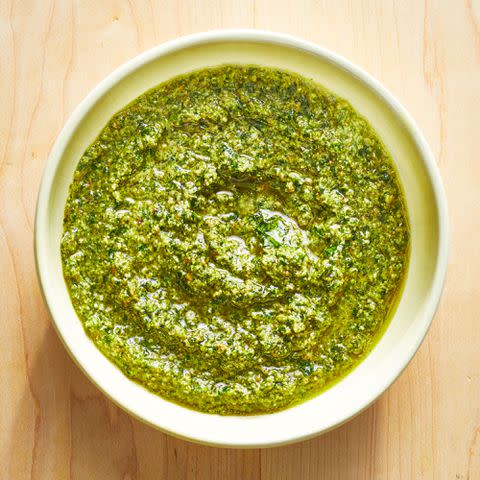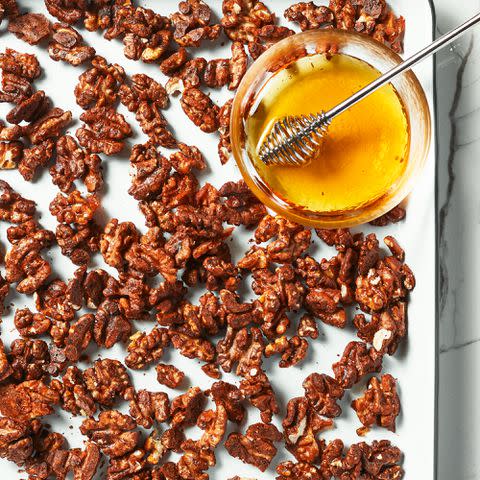8 Ultra-Healthy Foods High in Omega-3 Fats
Do your brain, heart, gut, and immune system a favor by reaching for these nutritious, fatty foods.

TanyaLovus/Getty Images
Fact checked by Haley Mades
When it comes to health-promoting nutrients, few get as much attention as omega-3 fatty acids. And while there are plenty of natural sources of this healthy type of fat, more supplements and food products are coming to market to capitalize on the trend. But what makes omega-3 fatty acids so important, and why are health professionals calling on us to include more of them into our daily routines? Here’s exactly what these types of fats are, how they benefit your health, and the best foods high in omega-3s.
What are Omega-3 Fatty Acids?
Taking a big picture view, fat is one of the three major macronutrient groups, alongside carbohydrates and protein. The fat nutrient category is then generally broken down into three main types of fats: saturated, unsaturated, and trans fats.
Within each of these groups, there are a variety of different kinds of fats (with the exception of trans) and their building blocks, called fatty acids.
Omega 3s are an unsaturated fat, specifically, polyunsaturated fat.
“Omega-3 fatty acids are a type of polyunsaturated fat that is essential for our health and wellbeing, meaning we must get them from food because our bodies do not synthesize them on their own,” explains Jordan Hill, MCD, RD, CSSD, lead registered dietitian at Top Nutrition Coaching. In this way, omega-3s are very similar to essential amino acids, which is partly why they get so much positive health press.
Generally, these fats are considered anti-inflammatory and are the counterpart to omega-6 fatty acids that are generally recognized as pro-inflammatory. And while some inflammation does play an important role throughout the body, like when we get injured or sick for example, the American population typically gets more than enough (if not too much) omega-6s on a daily basis. This is thanks to their prevalence in many cooking oils and processed foods. Meanwhile, Americans are generally not meeting their daily omega-3 needs.
Types of Omega 3s
“There are three types of omega-3 fatty acids: alpha-linolenic acid (ALA), eicosapentaenoic acid (EPA), and docosahexaenoic acid (DHA),” Hill says. ALA is usually found in plant-based sources, and EPA and DHA are more readily found in fatty fish. The body can convert ALA to EPA and DHA, but the rate of conversion is less than 15%, which is why there’s such a call from health professionals to eat more fish on a weekly basis.
Benefits of Omega-3s
But what benefits do omega-3 fatty acids have to make them so essential? For one thing, they’re a key component to cell membranes throughout the body, and this fact alone lends to their involvement in many vital functions. Here are some of the most notable health benefits associated with omega-3 fatty acids.
Brain Health
“DHA is a component of brain cell membranes, which plays a role in cognitive function, memory, and overall brain health,” says Hill. Research shows that optimal omega-3 intake can help to treat or prevent both neuropsychiatric disorders like attention deficit hyperactivity disorder (ADHD) and depression, as well as neurodegenerative diseases like Alzheimer’s and Parkinson’s.
Related: 6 Nutrient-Packed Foods to Eat for Better Brain Health
Heart Health
When it comes to heart health, omega-3s are almost always recommended by nutrition professionals. “From a cardiovascular perspective, omega-3s can help lower triglyceride levels in the blood, reducing risk for heart disease, while also enhancing the elasticity and function of blood vessels, which helps to maintain healthy blood pressure levels and improve blood flow,” Hill says. These fats may also aid in healthy heart rhythms. One review of the literature published in Nutrients even found omega-3s to be associated with a significant reduction in heart disease-related events, like heart attacks.
Related: Avoid These Foods for a Healthier Heart, According to Experts
Immune Health
Omega-3 fatty acids are also involved in the creation of eicosanoids: fat-based signaling molecules that play an integral role in the immune response. Hill adds, “omega-3s have anti-inflammatory properties that can help reduce the production of inflammatory molecules in the body.” Inflammation is a key component to many chronic diseases including cancer, type 2 diabetes, and autoimmune disorders.
Gut Health
Interestingly, omega-3s also act as prebiotics, or food for the beneficial bacteria found in the gut microbiome. In the biome, omega-3s contribute to the production of anti-inflammatory compounds like short-chain fatty acids which helps to improve the system’s overall health. The health of the gut microbiome is intimately tied to our overall digestive health, as well as whole-body health, especially immunity.
Child Development
These fatty acids are also highly important for pregnant women and new mothers. This is because they support optimal neurodevelopment in a growing fetus and may even support healthy lactation in breastfeeding women, thanks to its potent anti-inflammatory properties.
Additional Benefits
Some other bonus benefits of omega-3s include supporting eye health by helping to prevent or slow the progression of macular degeneration and diabetes management by aiding in better blood sugar management.
Omega-3 Fatty Acid Needs
What amount should you be aiming for on a daily basis to benefit from omega-3 fatty acids? While there are no official recommendations for this group of fatty acids as a whole, there are established recs for ALA, as outline by the National Institutes of Health (NIH), which are as follows:
Birth to 12 months: 0.5 grams (g)
Children 1 to 3 years: 0.7 g
Children 4 to 8 years: 0.9 g
Boys 9 to 13 years: 1.2 g
Girls 9 to 13 years: 1.0 g
Teen boys 14 to 18 years: 1.6 g
Teen girls 14 to 18 years: 1.1 g
Men: 1.6 g
Women: 1.1 g
Pregnant teens and women: 1.4 g
Breastfeeding teens and women: 1.3 g
However, one 2022 study found three grams of EPA and DHA was linked to improved blood pressure levels. Otherwise, “the recommendation from the Dietary Guidelines for Americans 2020–2025 is that we should consume one gram of omega-3s for every 4 grams of omega-6s,” Hill says.
Understandably, keeping track of grams and intake can be a daunting task day-in and day-out, so my general recommendation is to aim for a few good sources of omega 3 food per day.
Foods High in Omega-3s
When looking for omega-3 rich products, you can very easily be sucked into the supplement space, as there are countless options on the market. Similarly, “some food products, such as certain types of eggs, dairy, and plant-based milk, are enriched with omega-3s,” Hill notes. However, nothing beats whole food sources of this nutrient, and below are eight of the best ways to eat your omega 3s.
Salmon

Greg DuPree
Salmon Tacos With Grapefruit Salsa
It may not come as a shock to find salmon at the top of this list of foods for omega-3s. In three ounces of wild salmon you’ll find nearly 1.5 g of omega-3s, and in three ounces of farmed salmon, 1.8 g, mostly in the form of DHA and EPA. This difference is primarily due to the control over what farmed salmon are eating to boost their omega-3 levels.
Related: 18 Easy Salmon Recipes For Brunch, Lunch, and Dinner
Chia Seeds

Not all omega-3 sources have to be from fish, and chia seeds are an excellent example, though they only contain ALA. With over five grams of ALA per serving, it’s tough to beat the omega-3 power of this vegan option.
Anchovies

Anchovies do not only make for the most perfect puttanesca or homemade Caesar dressing, but they’re also full of omega-3 fatty acids. In a mere two ounces of anchovies you’ll find 1.2 g of these heart healthy fats.
Flax

Similarly to chia, flax is also a powerhouse seed when it comes to omega-3s. Flaxseed oil is especially potent with a staggering 6.7 g of ALA in a single tablespoon. This mild oil can be used for low-heat cooking, salad dressings, smoothies, and more.
Oysters

Getty Images
Shellfish and clams, like oysters, can also be super sources of omega-3s. As if we needed another reason to opt for raw oysters at happy hour, these briny delights offer an impressive 0.6 g per three ounces.
Walnuts

When it comes to tree nuts, walnuts are one of the best sources of omega-3s with 3.3 g of ALA in one cup. These make for the perfect topping for yogurt, chia pudding (double the omegas!), waffles, or salads—or snack on them after lightly roasting.
Soy

Soy products like soybean oil and tofu make excellent omega-3-rich foods. Soybean oil contains 0.9 g of ALA in one tablespoon, while edamame (soy beans) offer nearly 0.3 grams in a half cup. Soybean oil can substitute most vegetable oils in cooking while edamame can be eaten out of the shell with flaky sea salt or shelled and added to salads, salsas, stir-fries, pasta, and soups.
Seaweed

JENNIFER CAUSEY
Spring Fried Rice With Nori and Cashews
If you don’t eat fish, seaweed and algae may just be your secret to avoid turning to DHA and EPA supplementation. These are some of the only plant-based foods that contain these other omega-3 fatty acids. In fact, it’s from seaweed that all the fatty fish we’re told to eat get their healthy omega-3s. So, whether you opt for nori, wakame, spirulina, or kombu, you can’t go wrong with these sea greens.
Related: The 30 Healthiest Foods to Eat Every Day
For more Real Simple news, make sure to sign up for our newsletter!
Read the original article on Real Simple.

